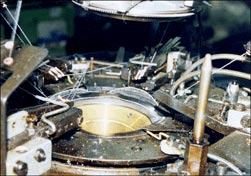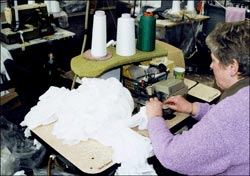Manufacturing a Pair of Tights
Ever wondered how a pair of tights are made? A step by step guide to how these garments are manufactured in the modern era. Thanks to T Jennings Ltd of Hinckley.

Knitting Legs for Tights
Rows of Matec circular knitting machines produce individual legs for tights.

The Knitting Needles
The machine shown has four yarn feeders that allow the machine to knit four courses at once. As each feeder passes by, the latch needles are raised to open the latch and receive the yarn. The needle then falls and the latch closes to allow the old course to be pushed off.

Controlling the Process
The shape of the stocking is controlled by a series of cams. Pins and holes on the cams determine the movement of the needles and the feeders. Needles are taken out of use and the feeders roll backwards and forwards on half of the cylinder to form the heel.

Feeding the Yarn
The yarn is fed from above the knitting head. The yarn cones on this machine include nylon and elastic feeds.

Removing the Leg From the Machine
Completed legs are cast off from the needles and drawn down a pipe by air. The pipe leads out of the machine into a collecting bag.

Seaming the Toe
The tight legs are taken from the knitting machine to a toe seaming machine. The machine automatically stitches the toe together and cuts off any excess fabric.

Prepared for Dyeing
Seamed legs are placed into nets and bagged up ready for sending to the dyers. The nets protect fine hosiery from being damaged during the dyeing process.

Back from the dyers
Once dyed, the tight legs are taken out of the nets ready for the next process.

Sewing the Legs Together
Two separate legs are placed onto the machine's grips. A cutter runs a short length down the two inner sides of the legs to create an opening for the body of the wearer. The grips then stretch the top of the legs open to allow a sewing head to sew the two legs together and trim off excess fabric. Completed tights are then taken from the machine.

Elasticated Tops
Once the legs of the tights have been joined, an elasticated band is sewn around the top of the tights. The band helps to hold the tights up when worn.

Quality Checks
Once the manufacturing process has been completed, the tights are placed onto a stand and checked for imperfections and holes.

Shaping Tights
Some tights in the product range are placed onto a heated inspection stand. The heat is used to shape the tights.

Passed the Inspection
Tights passing the quality checks are boxed ready for sending to the packing bay.

Packaging
Pairs of tights are folded and wrapped in a piece of paper. The paper has the product's brand name printed on it. The bundle is then placed in a bag and sealed.

The Warehouse
Finally the packaged tights are sent to the warehouse ready for distribution to retailers.